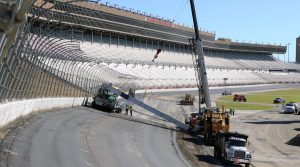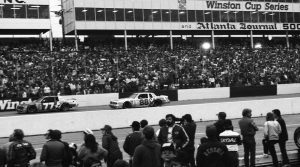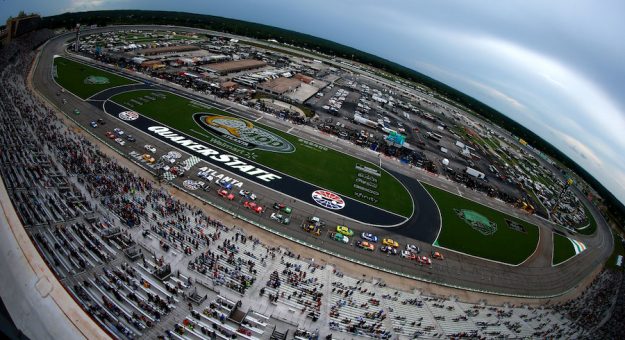Throughout much of its early existence, Atlanta Motor Speedway was a diamond in the rough, and decades passed before it could truly shine its very brightest.
With the opening of the 2.5-mile Daytona Int’l Speedway in February of 1959, superspeedway construction across the United States was a viable business proposition. A group of businessmen in Atlanta wanted to cash in on NASCAR’s growing popularity and find a place in the sport by building their own track.
A site was secured 26 miles south of Atlanta in Hampton, Ga., and construction began on a 1.5-mile race track during the spring of 1959.
Those involved in the new corporate venture were local businessmen Jack Black, T. Walker Jackson, Lloyd Smith, Carland Bagley, Ralph Sceiano and Ike Supporter. According to Black, some in the group saw selling stock more lucrative than promoting stock car racing.
“I don’t know if they intended on ever completing the track,” Black said in a 1994 edition of American Racing Classics. “They came out at $2 a share and there were very few rules and regulations as far as the Securities and Exchange Commission with over-the-counter stock or stock issued within the state. The group was not going interstate with the stock but selling it in the state.
“They wanted to sell stock and went from $2 to $4, then $5, $6 and then $7.50. When enough people got involved to buy stock, it almost forced them to start construction on the track.”

Delay after delay and managerial reorganizations led to a second group being put in charge. “… The project went down to nothing before everybody got together to bring it back to life and build the track,” Black said. “We all put money into it and bought more stock.”
That group included Black, Lester, Bill Boyd, an insurance executive who was also an attorney, Dr. William Gremmel, Garland Bagley and Nelson Weaver, a real estate developer and future president of the speedway.
Seventy percent of the work on the track was done in a 60-day period, including pouring 20,000 cubic yards of concrete, the erection of 19,500 feet of fencing and laying 20,000 tons of asphalt. More than 11,000 feet of guardrail was constructed around the 1.5-mile speedway, which included two 24-degree, 2,780-foot turns.
Glenn “Fireball” Roberts wheeled John Hines’ No. 22 Pontiac into victory lane after winning the inaugural Dixie 300 NASCAR Cup Series event on July 31, 1960, but the track was already in trouble. Officials sold $1 million worth of stock, but the facility cost $2 million to build.
The track’s operating capital was often short throughout the 1960s and there was substantial debt that had to be satisfied over a long period of time.

The track garnered the nickname “Atlanta Rainway” very early in its existence. For whatever reason, race days were often rained out and frequently rain also fell on make-up days.
By the end of the 1960s, the track had bled enough money that financial help was greatly needed to stay afloat. The track’s board of directors elected to merge with American Raceways, a group headed by Larry LoPatin that operated tracks in Texas, Michigan and California
American Raceways eventually went bankrupt, taking the Atlanta track with it. By 1971, the track was under control of a trustee and with ticket sales desperately slow at 22,500, there was no money to cover the purse for the upcoming NASCAR race.
After a guarantee from Charlotte businessman Richard Howard of a purse of $85,000, the race was completed.
Sixty-seven Cup Series races were run on the original configuration and the track was a favorite among many of the drivers.
“When I won at Atlanta in October of 1962, it was the old track,” said 1960 NASCAR champion Rex White. “I remember we were out of sequence as far as pit stops that day, so I had to draft some to stay with the leaders. Marvin Panch was ahead of me and with three laps to go, he ran out of fuel. From there, I motored on around and took the checkered flag and won the race.
“Back then, you had half-mile turns and quarter-mile straightaways, so you had to have a car that handled right. If not, it made for a really long day there. I loved racing at Atlanta.”
Businessmen Walter Nix and L.G. Dewitt took over the track in 1973 and operated it until O. Bruton Smith purchased it in 1990 as part of Speedway Motorsports. Had that not happened, the track may not be in business today.
In 1994, Smith added 46 condominiums at the northeastern side of the track overlooking turn four. In 1997, the track was almost completely rebuilt as the frontstretch and backstretch were swapped with the configuration of the track being changed from an oval to a quad-oval. The length was increased from 1.522 miles to 1.54.
In the first race for the new configuration on Nov. 14, 1997, Geoff Bodine set a track record with a lap of 197.478 mph.
Some drivers struggled to adapt to the new configuration.
“I liked the old Atlanta,” said three-time Cup Series champion Darrell Waltrip. “It’s funny. They turned Darlington around and it never felt the same. It was the same race track. Everything was the same, but it didn’t feel the same when they moved the start-finish line. Atlanta was the same way. It never felt the same the minute they changed the configuration.”
The most famous race on the track’s original configuration was the 1992 Hooters 500. Run on Nov. 15, it was the Cup Series finale and was also the last race of Richard Petty’s legendary career and the first race in the series for future champion Jeff Gordon.
Six drivers entered the event with a chance to win the Cup Series title. In the end, Alan Kulwicki won the championship by 10 points over race winner Bill Elliott.
Kulwicki died in a private airplane crash en route Bristol Motor Speedway on April 1, 1993.
Another memorable race came in 2001, three weeks after Dale Earnhardt’s death in a crash at Daytona Int’l Speedway. Gordon battled Kevin Harvick, who had replaced Earnhardt in Richard Childress’ Chevrolet, until the checkered flag. Harvick won his first Cup Series race by .006 seconds.
The track was filled with emotion as fans in the stands held up three fingers to honor Earnhardt.
“I don’t know how you could script it any differently. I’m sure this is going to be pretty difficult for all of us,” Harvick said in victory lane. “All I can say is this one is for Dale. … I think somebody was watching over us.”
Forty-eight races have been run at AMS since Smith hosted the first Cup Series race on the remodeled track in November 1997.
When NASCAR teams return to Atlanta Motor Speedway on March 20, they will race on a new configuration as construction crews have revamped the track since the last race there in July.
The 1.5-mile track now includes 28 degrees of banking in the turns and drivers will race 510-horsepower engines and seven-inch spoilers on their new Next Gen race cars.
Veteran driver Kurt Busch tested his 23XIII Racing Toyota on the layout and believes the new Atlanta will race more like a superspeedway.
“In NASCAR, we have our Daytona and Talladega style draft and those are on 2.5- and 2.66-mile tracks,” Busch said. “This is a mile-and-a-half. Things are going to be moving quicker. You’re going to be digesting things much faster and you’re going to have that Daytona and Talladega style feel here at a mile-and-a-half.”
The early investors in the track south of Atlanta couldn’t have imagined how far their vision would come over six decades.
